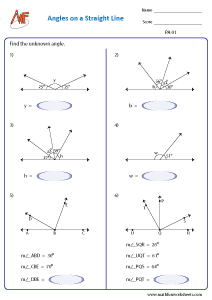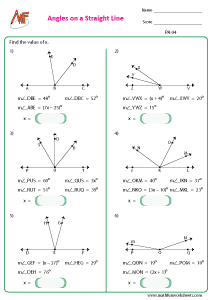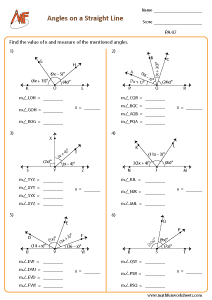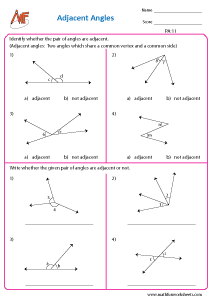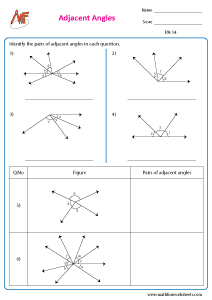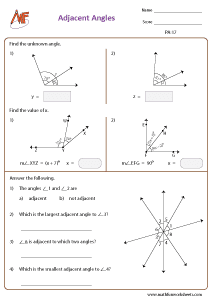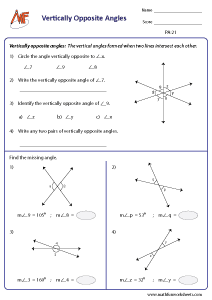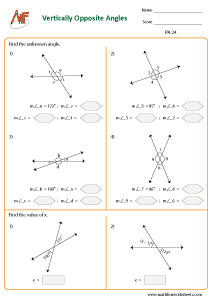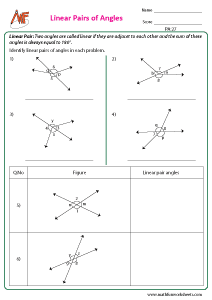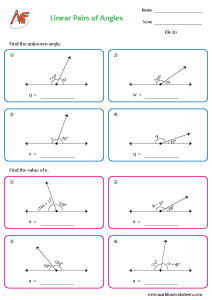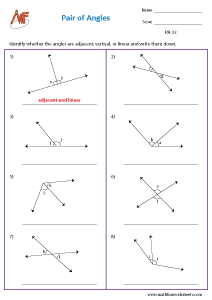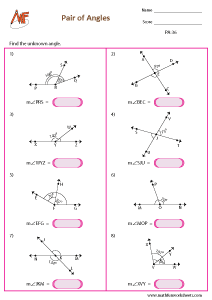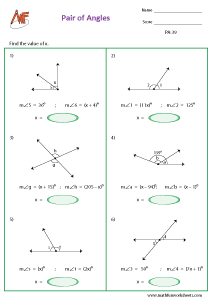- Home
- Geometry
- Angles Worksheets
- Pair of Angles
Browse by Topics
- English Worksheets
- Science Worksheets
- Kid's Corner
- Numbers & Operations
- Addition
- Subtraction
- Multiplication
- Division
- Decimals
- Place Value
- Roman Numerals
- Skip Counting
- Odd & Even Numbers
- Patterns
- Cardinal & Ordinal Numbers
- Rounding Numbers
- Estimation of Numbers
- Estimation of Time & Money
- Counting & Cardinality
- Comparing Numbers
- Ordering Numbers
- Fractions
- Prime & Composite Numbers
- Squares & Cubes
- Square & Cube Root
- Divisibility Rules
- Factors & Multiples
- Data Handling
- Algebra
- Ratio
- Least Common Factor
- Greatest Common Factor
- Percent Worksheets
- Proportion
- Order of Operations
- Scientific Notation
- Exponents
- Algebraic Expressions
- Evaluating Algebraic Expressions
- Simplifying Algebraic Expressions
- Graphing Lines
- Point Slope Form
- Two Point Form
- Two Intercept Form
- Equations
- Identifying Functions
- Evaluating Functions
- Function Table
- Domain and Range
- Trigonometric Charts
- Quadrants
- Polynomials
- Measurement
- Geometry
- Word Problems
Pair Of Angles Worksheets
Pairs of angles are fundamental concepts in geometry that help us understand the relationship between different angles formed when lines intersect or when shapes are created. These pairs include complementary, supplementary, adjacent, and vertically opposite angles, each with distinct properties and significance.
To begin with, complementary angles are two angles whose measures add up to 90 degrees. They often appear in right-angle triangles or when a right angle is divided into two smaller angles. On the other hand, supplementary angles are two angles whose sum is 180 degrees. These usually occur when two lines form a straight angle or a linear pair.
Now, we will learn more pairs of angles for grade 6 to grade 8 like linear, vertically opposite and adjacent angles here. Before you know all these pairs of angles there is another important concept which is called ‘angles on a straight line’. The sum of angles on a straight line is 180 degree. Thus, any number of angles on a straight line amounts to 180 degree.
Vertically opposite angles:
Vertical angles or vertically opposite angles are opposite angles formed when two lines intersect each other. Thus, two pairs of opposite angles are formed when two lines intersect. Here, the pair of opposite angles are equal. Refer the figure given below for clear understanding.
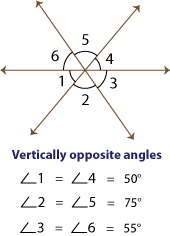
Adjacent angles:
Two angles are said to be adjacent, if they have a common vertex and a common arm. The angles should not overlap which means the other arms are lying on the opposite side of the common arm.

Linear pair of angles:
RELATED GEOMETRY TOPICS : 2D Shapes, 3D Shapes, Lines rays line segments and planes, Composing and Decomposing shapes
Pair of Angles Worksheets
Check if the pair of angles are adjacent

Check if the pair of angles are adjacent
Identify the pair of adjacent angles

Identify the pair of adjacent angles
Adjacent angles - mixed review

Adjacent angles - mixed review
Find the missing value - vertically opposite angles

Find the missing value - vertically opposite angles
Find the unknown angle - vertically opposite angles

Find the unknown angle - vertically opposite angles
Identify linear pair of angles

Identify linear pair of angles
Find the unknown angle - Linear pair of angles

Find the unknown angle - Linear pair of angles
Find the unknown angle - pair of angles

Find the unknown angle - pair of angles
Find the value of x - pair of angles

Find the value of x - pair of angles
Furthermore, adjacent angles share a common side and vertex but do not overlap. They are positioned side-by-side, and understanding them is essential when analyzing geometric shapes and solving problems involving parallel lines and transversals. In contrast, vertically opposite angles are formed when two lines intersect, creating two pairs of opposite angles that are always equal. This property is extremely useful in proving geometric theorems and solving for unknown angles.
Moreover, recognizing these angle relationships allows students and professionals to simplify complex diagrams and solve mathematical problems more efficiently. It also builds a strong foundation for more advanced topics in geometry and trigonometry. For instance, when working with polygons, knowing how angle pairs behave can help in calculating missing angle values and verifying the accuracy of constructions. Therefore, understanding pairs of angles is not only a key skill in academics but also a practical tool in fields such as engineering, architecture, and design.
By mastering these basic relationships, learners can confidently progress to more complex geometric concepts and real-world applications.


